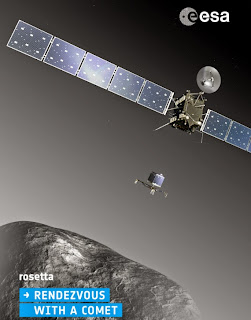 Around 18:00 GMT, and after 10 years journey connected with the spacecraft Rosetta, Phileas (Philae), a small spacecraft designed to land on the comet 67P, he carried out his mission successfully.
Around 18:00 GMT, and after 10 years journey connected with the spacecraft Rosetta, Phileas (Philae), a small spacecraft designed to land on the comet 67P, he carried out his mission successfully.
The weight 113 kg lander Philae succeeded smoothly in length 4 km comet, and then sent a signal back to Earth, which confirmed the success of the mission.
The Philae
The mission began 10 years ago with the launch of Rosetta Philae who brought a smaller spaceship. A few hours ago, Philae, which is the size of a washing machine, disconnected from Rosetta and began to fall to the comet. The fall lasted about 7 hours and the Philae lander managed to smoothly. Although part of the landing was selected to be as smooth as possible, it was not certain that the Philae would be able to land smoothly.
The Director General of ESA, the Jean-Jacques Dordain, said "We all learned that the Philae landed. This is a big step for mankind. This is the earthly intelligence that makes the difference. "
The special hooks that were designed to be thrown to the ground during the landing was not used for this reason we do not know if the Philae managed to remain in the party landed. Scientists working on how to shoot the hooks to make sure the position of Philae. According to the pressure received by the Philae landing wheels touched the surface and the landing was smooth.
No spacecraft has landed on the comet, although the Nasa with Deep Impact, 2005 sent a mini spaceship to collide with a comet to see what ingredients consisted of.
The Journey of 10 Years
After the launch of Rosetta in 2004, the spacecraft used 3 times Earth's gravity as a slingshot to accelerate the speed needed to reach the comet. The Rosetta spacecraft using solar panels to have energy for electronic systems, but when he arrived at the most distant point from the sun, where he arrived only 3% of the light that reaches the Earth, should be put in a form and performing Sleep only basic functions. In January 2014 the Rosetta «awakened" successfully in August reached the 67P.
Comets Are The Primary Elements Which Formed Our Solar System
Comets are very important goals as large frozen pieces are left over from the creation of the planets 4.6 billion years ago. Comets are thought to have maintained the primary elements which created our solar system, says Jean-Pierre Bibring, a scientist who works with the Philae.
The complex molecules are considered to be the original pieces which created life may still exist on the 67P / Churyumov-Gerasimenko. The Philae has about 60 hours to do all the experiments using 10 institutions before its batteries run out. If Philae is perhaps the shadow has the possibility to charge the batteries with solar panels has.
The Rosetta has already amassed valuable information, as no one ever had followed a comet for so long. Already know how to smelt the environment of the comet from the chemical elements which has acknowledged. The scent would smell if anyone was on the comet would be quite uncomfortable as like rotten eggs or horse urine. Also as the temperature rises as the comet approaches the sun seen firing more water from its surface.
The Rosetta costing 1.4 billion euros, and will continue to accompany the comet for some time. The mission will end in December 2015 when it passed to the closest point to the sun.






0 comments:
Post a Comment
We are eager to see your comment. All comments will moderate by the hand of man, and all links are nofollow.